Lately I seem to have a lot of clients with a similar presentation. I think this revelation has more to do with me than them. Specifically, my observations of bodies and how they move through a particular lense. Kinda like when you get a new pair shoes and all of a sudden you’re acutely tuned in to what everyone else is wearing on their feet, when perhaps you’ve never noticed nor cared before.
Anyhoo, after finding success in the treatment of pain with this such particular presentation, I really started honing in on what seems to be a reasonably common occurance. In order to explain what this common pain presentation is, let’s first talk about Myofascial slings.
Myofascial slings: The back and front of it
Many Allied Health Practitioners and Health & Fitness Professionals subscribe to the existence of anatomical or myofascial slings. Which are, without getting too technical, chains of muscle, connective tissues and ligaments. Specifically four chains, in a sorta front, back and sides kinda fashion. It is suggested these four chains work together to create movement and stability.
I am one of them…. a subscriber to the existence of myofascial slings that is, not one of the slings, obviously. This year in particular, I’ve been really interested in significant imbalances in the anterior, comparative to posterior oblique slings. Put simply, I’ve taken an interest in the DIFFERENCE IN THE STRENGTH AND LENGTH OF THE MUSCLES in your FRONT (deeper stomach & inner thigh) and your BACK (back, butt and back of thighs). I’ve then applied particular movement principles to my programming in the gym in the treatment of this imbalance.
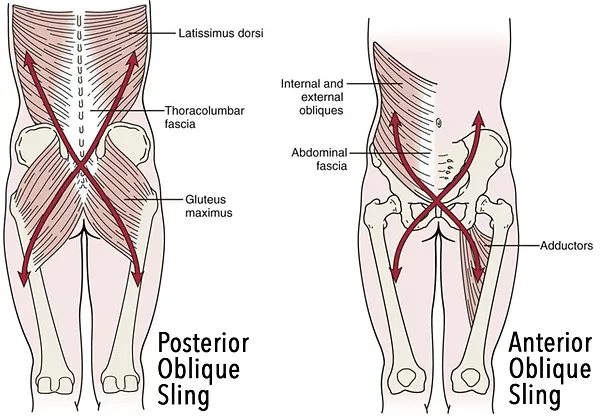
How to spot a significant ‘back to front’ imbalance:
SYMPTOMATICALLY, I see the gross imbalance of the anterior and posterior sling present in the clinic:
- predominantly with lower back pain
- by way of appalling flexibility (aka seriously tight Hamstring and Calf muscles)
- but also with knee pain (my own)
- with stiff ankles, Achilles pain and plantarfasciitis
- and the type of neck & shoulder pain that accompanies a forward head position and rounded shoulders
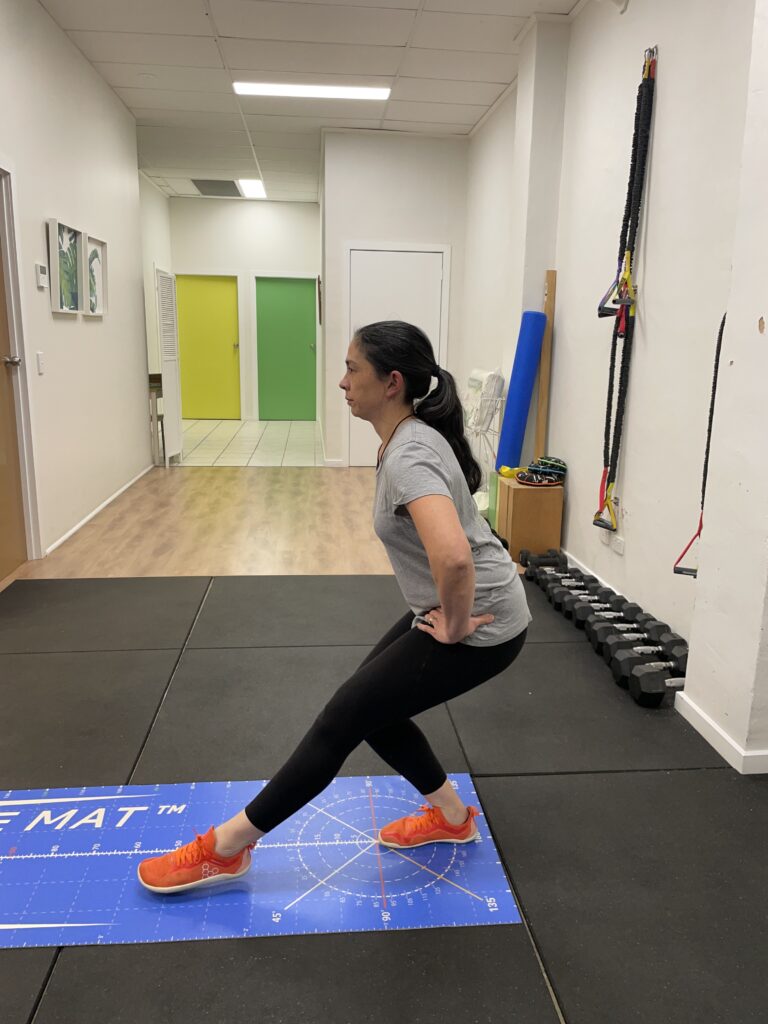
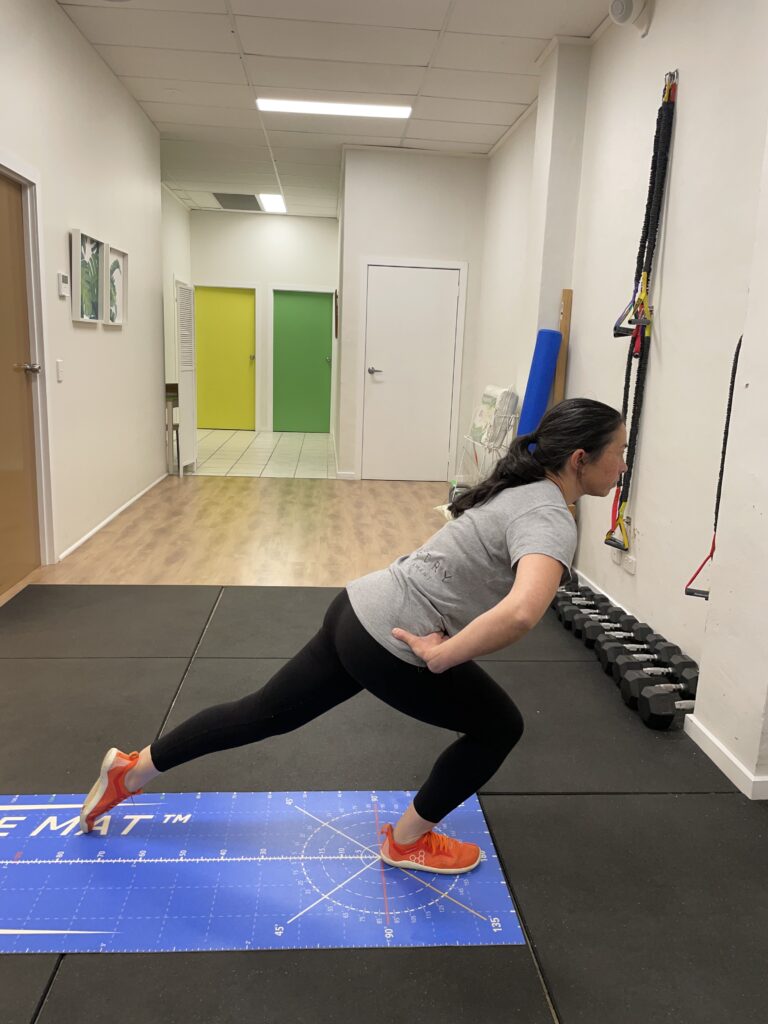
CLINICALLY, with Super Session testing, I can measure this anterior/posterior imbalance with the:
- Star Excursion or Y-Balance Test (as per images ablove, see Blog #4 for description) and with the
- McGill Torso Endurance Test
- The McGill Torso Endurance Test gives us information regarding basic trunk strength (front, back & sides).
- The SEBT or Y-Balance Tests, help us learn about lower limb strength, balance, mobility & proprioception (in 8 possible directions).
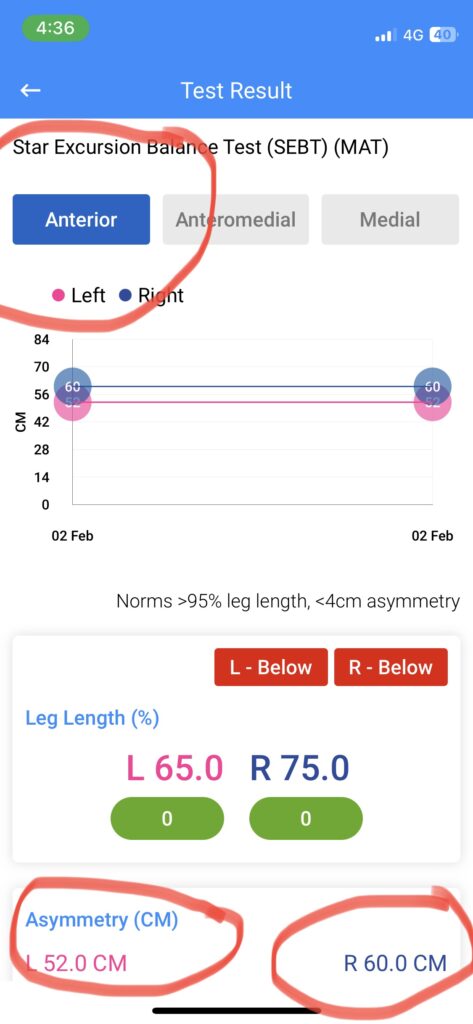
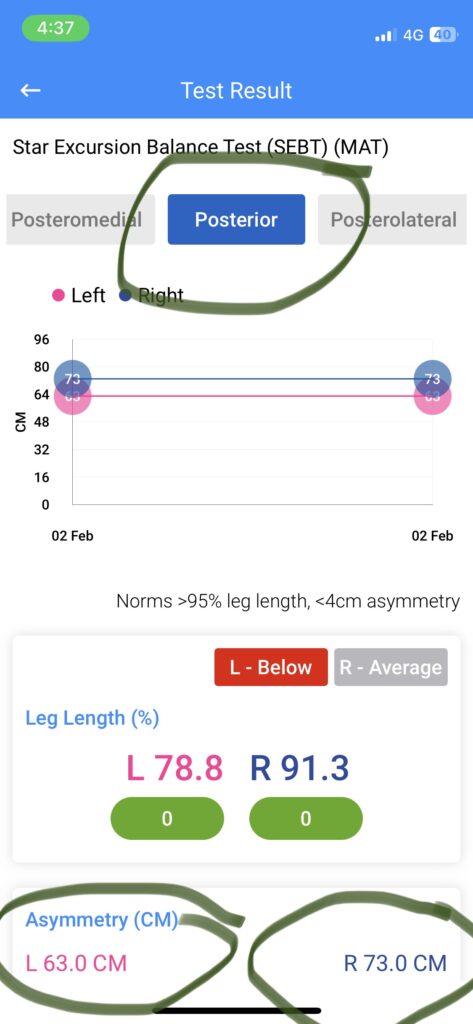
Anterior vs Posterior= my lesser vs greater reach
The above images demonstrate my pre-program Star Excursion Balance Test reaches:
ANTERIOR (forwards): circled in red
POSTERIOR (backwards): circled in dark green
Hideous as it is, let’s set aside the whopping left to right asymmetry and look to the contrast from the two different test results as a whole, ANTERIOR VS POSTERIOR. They should be relatively equal. Normative values suggest we should reach around 90% of our leg length, both forwards and backwards.
My test results not only demonstrate the limitations of my left leg, but also indicate the imbalance in strength and length of the muscles of the front, back and sides of each hip & leg (& also of my trunk). Allowing a far greater (& more stable) length of reach behind than in front.
Left side: FORWARDS=52cm BACKWARDS=63cm
Right side: FORWARDS= 60cm BACKWARDS= 73cm
I recently observed an extreme example of this imbalance in a 21yo male with severe and chronic lower back pain. His back to front discrepancy was 45cm!! He could reach almost half a metre more behind him than in front. (They should be relatively equal!!) In my opinion, this was a huge breakthrough in the understanding of his back pain, which had thus far been untreatable, despite numerous visits to various Allied Health professionals. I’m quite confident he’ll experience significant reduction in symptoms of back pain as we start to reduce this imbalance.
What to do?
Restore the imbalance, obviously….. but how?
Through experience, I’ve come to realise this is more difficult than it seems. Especially with our current almost obsession with “glutes, glutes, glutes!!” Prescriptions of ‘bridges‘ and ‘crab walks‘ are pretty standard with most types of lower back complaint these days. Along with the general suggestion to ‘strengthen your glutes‘, but I’ve personally found traditional glute strengthening exercises can often make little difference and sometimes worsen symptoms.
This focus has taken me on a journey with movement that has had me take a hiatus from squatting (shock horror!), scale back my fixation on pulling and reign in my promotion of the single leg balance.
Why?
Through my work with clients in the gym in recent years I’ve learned that it’s really hard to quieten the posterior oblique sling. When there’s a front to back imbalance the glutes (& Hamstrings) want to do it all! Gluteus Maximus is the extrovert at the movement party, front and centre with every motion regardless of request for involvement, crushing any chance poor Gluteus Medius, Minimus or any of the more petite glute muscles ever had of collaborating with said motion. And rendering the hip flexors and adductors at a loss to counter and provide the equilibrium required for stable movement with every hinge of the hip.
And so, for now, traditional squatting I do not.
Isolated hip hinging, nope.
Whole body movements, yes but pulling, not as much as before.
Even single leg squats have been taken off the list when it comes to treating clients who present with pronounced front to back imbalance in the initial stages.
I’ve learned the body almost needs to be tricked to move in a way that ensures a more balanced involvement of hip, trunk and leg musculature. I’ve learned to force movements that make it difficult for Gluteus Maximus to lead the hip hinging party, to allow the much weaker hip muscles to get in on the action. Permitting them to actually benefit from strength training and to slowly start to lessen the gap between front and back.
Through my observations both personal and professional, this shift and focus with movement principles has been pivotal in the treatment of chronic pain and repetitive injury with this presentation. The results speak for themselves, change in symptoms is often experienced within a mere few sessions in the gym, sometimes just after one.
For this lover of the barbell and traditional lifts, this is a temporary change in my strength training, (I will squat again!!) but for now my focus in the gym is to fix my gammy left leg and to lessen the gap between front and back.
HOMEWORK:
Refer back to your Blog #4 homework and compare your forwards to backwards reach. Is there an imbalance? Do you experience:
- back pain (worse with squatting, deadlifting or simply with standing after prolonged sitting)
- knee pain (especially the type that hasn’t shifted no matter the exercises/rehab undertaken)
- SUPER TIGHT HAMSTRINGS & CALFS
- Achilles or foot pain
- neck pain or headaches (accompanied by a forward head/chin poke)
Perhaps the ‘back to front’ imbalance might be something worth looking into??
Follow me on Facebook and Instagram for regular updates on “Tracey’s personal movement plan for action’. Where I’ll be sharing all the ugly results from my MASSIVE 2.5hr long Super Session, video analysed images of MY poor movement patterns, musings on my training experiences and more!
And if you’re interested in learning more about your body and how it moves, you can book an appointment below.